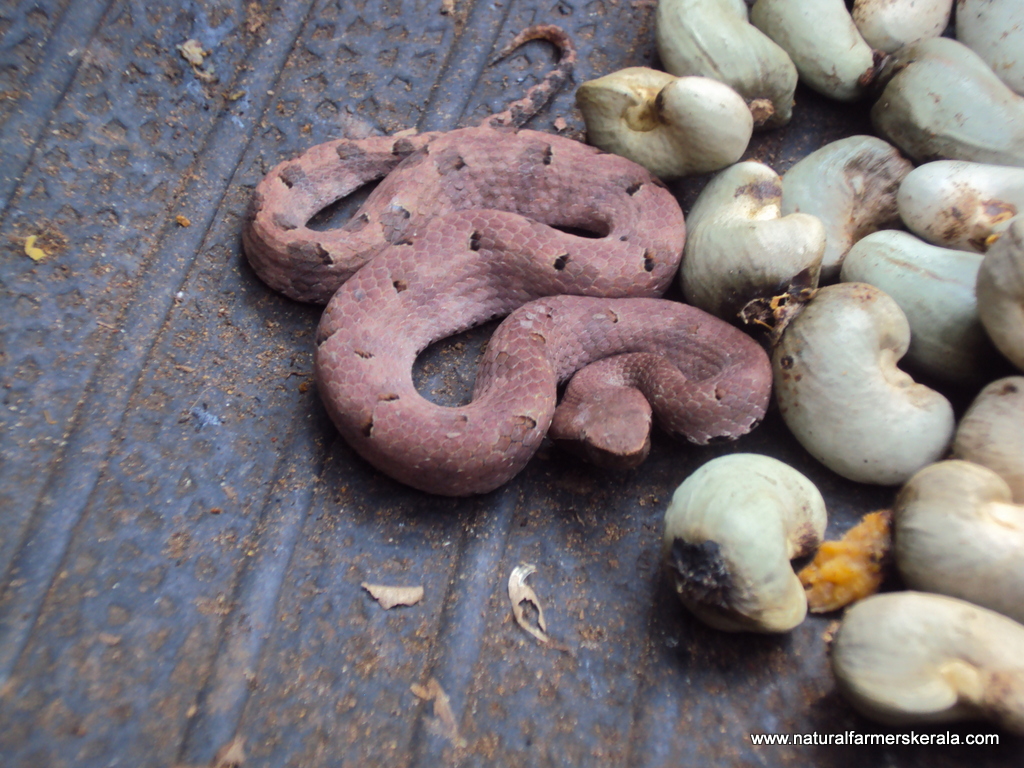Identifying Snakes and other Poisonous Creatures of Kerala

Continuation of Nonvenomous – Venomous Snakes and other Creatures found in Kerala
Bronzeback tree snake in the below image known as mara pambu has a mild form of venom, Harmless to humans.

Hump Nosed Pit Viper / Hypnale hypnale / Churutta
This snakes are only found in India and Srilanka. It is a very small snake. Mostly found in leaf litter. This snake is very slow and almost feels dead but it delivers amazingly fast strikes when irritated. It also shakes its tail like rattlesnakes. Single bite is very harmful to humans, blood loss occurs from all body openings including skin pores. Death occurs in 4 to 6 hours. Even if the person survives with proper antivenom administration, severe permanent tissue damage will occur. In short if you get bitten by this snake. Life is over.
Spotted this fully grown snake while moving cashew-nut leaves with bare hand. Lucky enough it didn’t bite. Initially I felt it was dead. However to my surprise it struck the stick in a split of a second. I could not even see the strike.

Some other Poisonous creatures commonly found in Kerala.
Hammerhead Worm / Chattuka Thalayan
This species comes under flat land worms. The hammer head is generally non poisonous but considered a pest by vermiculturist because they feed on earthworms. However flat worm in the below image is very poisons, it is immediately killed when spotted in Kerala using salt. It doesn’t bite, but the poison passes from the mucus trail left by it. Yellow, red, blue and some other bright color are signs of danger in nature.

Wasp / chekali
There are many types of wasp found in India. Most of them sting. It is most of the times painful with swelling at the stung area and discoloration of skin. Solitary wasp are not very dangerous but social wasp attack in large numbers and it can become fatal. Novice misunderstand them as bee colony.
Asian Hornet / kadenel
Unlike wasp and bees. Hornets are extremely strong, their body is somewhat strong like a rhinoceros beetle. Hornet sting is extremely pain full. It has neuro toxin venom. If multiple bite is delivered above heart level or to any major vein death can happen in a few hours. If below heart level chances are less. However it also depends on the particular person immune defence capacity. Severe and uncontrollable trembling occurs at the bite area with burning sensation. Also bite area turns bluish and swells.
Toddy tappers in Kerala always encounter them on coconut trees. Hornet loves toddy. Tappers are always at the risk of losing their lives.
Best and only traditional treatment for hornet bite is consuming and liberally applying the juice of flower and leaf of pigeon peas / thuvara parippu (toor dal).
Few days back lost all my bee colonies because of hornet. they kill bees with their strong mandibles, take their larvae and honey. In a matter of hours they can take down a large bee colony. I also feel Indian bees have cross breed with other bees. Native bees normally defend their colony well by attracting hornet into their hive and encircling the hornet and killing it with heat generated by several bees.

Gaint Asian Hornet / Kat Kadnel
This type of Hornet is extremely dangerous one stung can be fatal. They have blackish apperance and almost twice the size of Asian yellow black stripped hornet. As the name resembles Kat(Forest) Kadnel, they are normally seen in thick vegetation. However it can be occasionally spotted in villages. As of now I don’t have an image. Will update if I am able to click an image. No online resources have the right image of Kat Kadnel from India.
Spiders
There are many types of spiders on western ghats. Most spider bites are harmless to humans. The ones that build webs on trees and houses are mostly non venomous and hardly bite humans. Other spiders don’t need web to catch prey instead hunt using venom. Spider in the below image looks somewhat similar to tarantula(it has tiny hair on belly area). However it is Huntsman spider commonly found in most houses of Kerala, they do bite humans when hurt or while carrying eggs. Flesh starts to rot and ooze liquid at the bite area. Bite area will have several small bumps with severe itching(it is very mild not to worry much but treatment is required or else it may get infected and deep tissue may rot). But Kerala also hosts tarantula spiders, Immediate treatment is required for tarantula bite, severe complication are involved, even body gets crippled. As of now I don’t have an image of tarantula, will post whenever I encounter.

The hunstman spider bite is not fatal but as mentioned earlier flesh starts to rot, treatment is required. Tricky part is the same bite area will rot again the next year and a year after. please follow the treatment. kottakkal arya vaidya sala offers medicine like Vilwadi kashayam and Gulika(traditionally vilwadi is prepared using bael tree root along with 10 other herbs grinding the mixture with goats urine. I wonder modern day ayurvedic companies use healthy goats urine and not stall grain feed goats urine). Please note ayurveda is not over the counter medicine, consult a physician.
Scorpion and Centipede – Scorpions and centipedes are also commonly found in houses and they deliver nasty sting and bite. But it is not fatal. Incredible pain is felt for 24 hours.
First aid for Mild Venom Bite
Vishapacha
This is a perennial shrub. This plant is very effective for poison treatment. It is my understanding that this plant is also very effective for permanent treatment of bleeding piles(Hemorrhoids). This herb is located throughout Kerala mostly in wet areas like paddy fields. Locally it is known as Naga-Padam naga means cobra and padam hood.

Cheriya Ulli/ Small Shallot
Grind small shallot well and apply the paste to the bite area, this has to be followed immediately after the bite or stung.
Tulsi / Ocimum tenuiflorum
Tulsi leaves can also be used in similar way for minor bites of insects.
How to keep Snakes away from your Property
Plant Vembyu (Vacha-Hindi)
Snakes dislike the smell of vembyu. Small variety of vembyu is the best to keep snakes away and traditionally it was used to treat severe infected wounds in livestock and even treat rabies. Scavon vet cream by Himalaya has vacha one of the main ingredients. Traditionally people planted Tulsi, aromatic and medicinal plants near the house to keep away insects, pest, bacteria etc.
Nagadali Plant / Common Rue
This plant is also effective in keeping snakes away. Although I have not seen the plant- It seems it is very effective as per some people who have used it.
Urine
Cows Urine or even human urine is effective to keep snakes away. Snakes normally don’t come near the cow shed. They even move away if they sense approaching cattle.
Garlic
Plant garlic around your house or drop garlic and its peel in your property. Snakes dislike garlic. It is very effective. Garlic for snakes is like pepper to humans.
Kerosene
Kerosene is very effective in keeping snakes away. If snakes get into your house pour a little kerosene in the room and in a few minutes you will see snake leave the place.
PS: Bael / stone apple leaf resembles the shape of the trident. Leaf is offered to Lord Shiva in Puja. Interesting part is Lord Shiva is linked with snakes(cobra). Almost every bael tree I have seen has lots of holes near it’s base area on the ground. Most elders ask their kids to keep away as they have most of the time witnessed snakes near koovalam tree. Root is one of the main ingredient used to treat venomous bites. Lord Shiva, snakes, poison treatment, trident shape of bilva leaves everything is interwoven.
I will keep updating this page as and when I learn and understand more on this topic.
Credits & References
- Hammerhead Worm / Chattuka Thalayan – http://en.wikipedia.org/wiki/Bipalium
- Wasp / chekali – http://en.wikipedia.org/wiki/Wasp
- Asian Hornet / kadenel – https://en.wikipedia.org/wiki/Asian_hornet
- Gaint Asian Hornet / Kat Kadnel – https://en.wikipedia.org/wiki/Asian_giant_hornet
- Bael tree – https://en.wikipedia.org/wiki/Bael
- Visha pacha – https://groups.google.com/g/bodhi-nighantu/c/pgsAJ2bqpRs
- Nagadali Plant / Common Rue – http://en.wikipedia.org/wiki/Ruta_graveolens
- Article co-authored by Sandeep Saini
- Great resource on Indian snakes with images – http://www.snake-planet.webege.com/
15 Replies to “Identifying Snakes and other Poisonous Creatures of Kerala”
Comments are closed.







Great job, well informed…..
Thank you….
I heard that Mangoose and snakes are enemies. I found they were not attacking each other even they were in the same vicinity moving.
Any fact is behind it?.
very useful article thanks to you
Do you have any information about this dreaded spider called ‘ooranpalli’ in Thrissur?
————
Not sure. Sorry for delay in reply.
Oorampuli is a very aggressive poisonous spider seen in Kerala. Unlike snakes, it may run after you and bite.Symptoms of poison are excruciating pain and severe muscle cramps all over the body. Fatal in children if untreated. Treatment is injections of muscle relaxants.